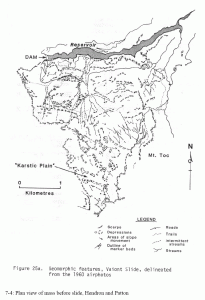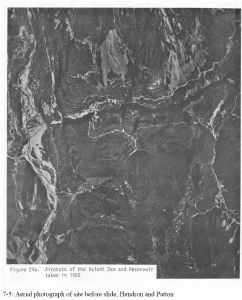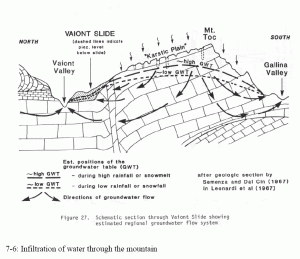A slope stability failure is more commonly known as a landslide, particularly among non-engineers. This type of failure occurs when the weight of a soil mass overcomes the soils shear resistance along a failure plane. Water within soil increases its unit weight while reducing the shear strength. As a result, water and water pressures often play a role in triggering a slope stability failure.
The Vaiont Dam disaster of 1963 was a classic slope stability failure. Ironically, the dam itself did not fail and stands today. The dam is a thin concrete wedge in a narrow gorge. A vast soil mass falling into the reservoir triggered a massive wave that blew over the dam and destroyed villages downstream.
The Vaiont Dam was part of an extensive system of dams, reservoirs, and hydroelectric powerhouses located in the Piave River Valley, high in the Italian Alps. The elements of this system were linked by tunnels and pipelines (Ross 1984, p. 131).
On October 9, 1963, at 10:41 p.m., approximately 270 million cubic meters (353 cubic yards) of rock fell into the reservoir, moving as fast as 25 m/s (82 fps). A tremendous wave of water blew over the dam, virtually the entire reservoir, sending a 70 m (230 ft) wall of water down Vaiont gorge. It destroyed the town of Longarone downstream, and severely damaged or destroyed the hamlets and villages of Villanova, Codissago, Pirago, and Fraseyn. 2,043 people were killed, including 58 of the utility’s employees (Wearne 2000, pp. 213-214). The population of Longarone before the disaster had been about 4,600. The flood also knocked out many access routes, hampering rescue operations (Ross 1984, p. 132).
The slide moved a 250 m (820 ft) thick mass of rock about 300-400 m (980-1300 ft) horizontally. It pushed the old slide mass up the far slope. Trees and soil along the Vaiont Valley were removed as high as 235 m (770 ft) above the reservoir level (Hendron and Patton 1985, p. 8)
The dam, however, stood. It had withstood a force of approximately 4 million metric tons (4 million tons) of water, roughly eight times the force for which it had been designed. The dam is still there, but there is no water behind it (Wearne 2000, p. 217-219). There was a small gouge in the concrete about 1.5 by 9 m (5 by 30 ft) along the crest near the left abutment (Ross 1984, p. 132).
The volume of the slide was slightly larger than the working volume of the Vaiont Reservoir. It was more than twice the volume of the largest earthen dam ever built, the Fort Peck Dam on the Missouri River in Montana. Because of the great volume, it was not practical to remove the material from the reservoir to restore the dams function (Ross 1984, p. 134).
The key document on this case study is The Vaiont Slide: A Geotechnical Analysis Based on New Geological Observations of the Failure Surface, Volume I, Main Text, Technical Report GL-85-5, published by the U.S. Army Corps of Engineers, U.S. Army Engineer Waterways Experiment Station, Vicksburg, Mississippi (Hendron and Patton 1985). It may be difficult to find except on loan from some large university engineering libraries.
The Vaiont Dam case study is covered in pages 206 through 225 of collapse by Wearne (2000) as well as pages 127 and 130 through 139 of Ross (1984). Wearnes chapter contains accounts from engineers and survivors of the disaster. Engineering News-Record reported on the case on October 17, 1963, and December 7, 1967, issues, and published an editorial in the October 24, 1963, issue.
A very similar mechanism caused the 2005 Bluebird Canyon landslide near Los Angeles, California. This case is featured on the Modern Marvels Engineering Disasters 17 DVD/video.
This case study is discussed in Chapter 7 of the book Beyond Failure: Forensic Case Studies for Civil Engineers, Delatte, Norbert J., ASCE Press.
Illustrations from Chapter 7 of the book Beyond Failure: Forensic Case Studies for Civil Engineers, Delatte, Norbert J., ASCE Press.








